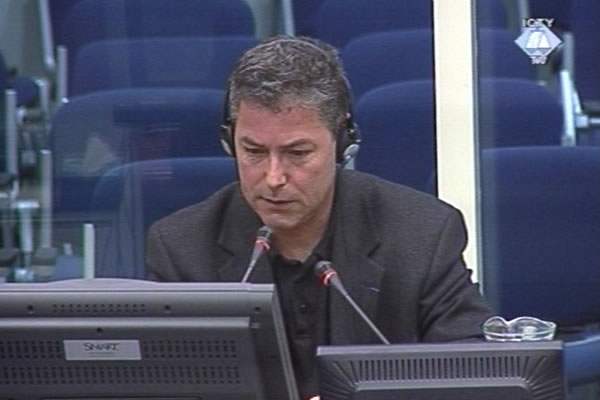Home
FOLLOWING THE TRAIL OF SREBRENICA CRIMES
Former head of the OTP Srebrenica investigation team Jean Rene Ruez completed his examination-in chief at the trial of Zdravko Tolimir. The former chief of security in the VRS Main Staff is charged with genocide and other crimes in Srebrenica and Zepa in 1995
 Jean Rene Ruez, witness at the Zdravko Tolimir trial
Jean Rene Ruez, witness at the Zdravko Tolimir trial On the second day of his evidence at the trial of Zdravko Tolimir, former head of the OTP Srebrenica investigation team completed his presentation of the investigation his team started immediately after the fall of the Srebrenica enclave in July 1995. In late June 1995, Ruez was already in Tuzla; he arrived in Srebrenica for the first time in early 1996.
Yesterday, the witness identified the routes the population used to withdraw from the enclave before the VRS troops which entered Srebrenica on 11 July 1995. Ruez continued to mark the spots where men were gathered and separated from the women and children, where parts of the column heading towards Tuzla surrendered or were arrested and places where prisoners of war were detained. Today Ruez showed on the map of Eastern Bosnia locations where Bosniak captives were executed and buried.
The investigation established that executions took place at the Branjevo military farm, the dam near the village of Petkovci, in a field near the school in the village of Orahovac, in the village of Kozluk, in the Cerska valley and in Pilica, where in the summer of 1996, the investigators found the Culture Hall, locked and undisturbed. On 16 July 1995, about 500 prisoners were executed there. Photos and video footage taken in the hall show how samples of ‘blood, hair and human tissue’ were recovered from the walls and various personal belongings and documents were found on the floor.
Ruez showed the locations of primary graves on the maps: in most cases, they were close to the execution sites. Ruez also showed the so-called secondary graves. The victims’ remains were moved from primary graves and reburied there.
Ruez described how the investigators found each execution site, and primary and secondary graves. Investigators learned of some of the execution sites – such as Orahovac and the Petkovci dam – from survivors. Drazen Erdemovic provided information on the execution site at the military farm in Branjevo; he was in the firing squad there. Where there were no survivors, the investigators obtained information indirectly. In the case of Kozluk, for example, the information was provided by a person in a refugee camp in Germany, whose relatives, still in the area, spoke about the executions in July 1995 and the person relayed the information to the OTP in The Hague.
[IMAGE]4688[/IMAGE]With a series of photos, aerial shots and video footage, Ruez identified those sites and explained the procedure of locating and exhuming mass graves. Aerial photos provided by the US government were of particular importance for the identification of secondary graves. By comparing photos of the terrain taken over a period of three to four weeks, the investigators could see the difference in the soil structure, indicating that it had been dug up.
Human body parts were found in secondary graves; those could be linked to two or even three execution sites and primary graves. Forensic experts and anthropologists in the field were able to determine this on the basis of items recovered in secondary graves which came from different execution sites.
The accused Zdravko Tolimir today began his cross-examination of the witness. Tolimir will continue and complete his cross-examination after the Easter break at the Tribunal.
Linked Reports
- Case : Tolimir - "Srebrenica"
- 2010-03-29 SREBRENICA CRIMES RECONSTRUCTED ON PHOTOS
- 2010-03-25 TOLIMIR’S WANTS TO EXAMINE SREBRENICA FOOTAGE
- 2010-03-22 NEW TESTIMONIES OF SURVIVORS
- 2010-04-26 FOURTH TESTIMONY OF A SURVIVOR FROM THE PETKOVCI DAM
- 2010-04-27 HOW THE DRINA CORPS ARCHIVES CROSSED THE DRINA RIVER
- 2010-05-03 TOLIMIR INVOKES MIRSAD TOKACA’S CLAIM
